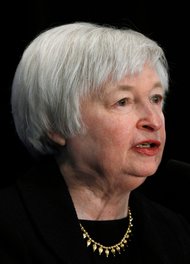Stocks on Wall Street slipped on Monday as upbeat economic data from Germany and China was countered by a Federal Reserve official’s remarks that the Fed could begin to scale back its stimulus measures this year.
In late morning trading, the Standard Poor’s 500-stock index was down 0.7 percent, while the Dow Jones industrial average fell 0.4 percent and the Nasdaq composite was off 0.7 percent.
Germany’s private sector grew in September at its fastest rate since January, and a survey showed Chinese manufacturing activity accelerated to a six-month high in September, giving equities relative support.
Referring to the timeline that the Fed chairman, Ben S. Bernanke, articulated in June, William C. Dudley, the president of the Federal Reserve Bank of New York, said the framework is “still very much intact.”
Investors were surprised last week when the Fed decided not to reduce the asset purchases from the current $85 billion monthly pace after many expected a change in policy would come in September.
Other Fed officials will be on the speakers’ circuit on Monday. Investors will be paying close attention after James B. Bullard, chief of the St. Louis Fed, said on Friday that policy makers could still decide to start trimming the central bank’s stimulus in October if inflation and unemployment data warrant it.
“We had some good news out of China and Europe and the elections in Germany are favorable for the euro zone, but focus remains on the Fed,” said Peter Cardillo, chief market economist at Rockwell Global Capital in New York. “Fed speakers are going to keep this market on edge, will continue to keep it guessing when they will begin to taper.”
The S. P. 500 and Dow industrials hit record highs last week after the Fed ignored investor expectations by postponing the start of the wind down of its massive monetary stimulus, saying it wanted to wait for more evidence of solid economic growth.
The prospect of a government shutdown or even a default in the coming weeks could keep markets jittery even as Wall Street analysts sense the current drama is likely to feature more bluster than bravado.
Apple shares gained 4.1 percent, building on momentum from last week, after it said it sold nine million iPhone 5s and iPhone 5c models over the weekend since their launch on Friday.
Citigroup led the S. P.’s financial sector lower a day after The Financial Times reported that Citi had a significant drop in trading revenue during the third quarter, which could hurt the bank’s earnings. Shares in Citigroup fell 3 percent.
United States-traded shares of BlackBerry fell 5.8 percent after the Canadian smartphone maker announced on Friday a change in focus away from the consumer in favor of businesses and governments. The move has fueled fears about BlackBerry’s long-term viability.
German shares closed lower though they remained near last week’s record high a day after Chancellor Angela Merkel won a landslide victory in the general election. Her conservatives may need center-left rivals to form a coalition government.
European stocks hit a five-year high last week, and Nick Beecroft, chairman and senior market analyst for Saxo Bank capital markets, said Ms. Merkel’s election win was “a ringing endorsement” to ensure the euro survives.
Ms. Merkel’s victory gave the euro only the briefest of lifts, however, because she still needs a new coalition partner to rule.
Having initially gained a quarter of an American cent, to $1.3555, the euro faded to $1.3492.
In Asia, shares in Shanghai gained 1 percent while Hong Kong’s Hang Seng index slipped 0.6 percent. Australian shares were down 0.5 percent, and Japanese markets were closed for a holiday.
Benchmark crude oil continued its slide, reflecting increasing confidence over supplies, down $1.43 a barrel, at $103.32.

Article source: http://www.nytimes.com/2013/09/24/business/daily-stock-market-activity.html?partner=rss&emc=rss




